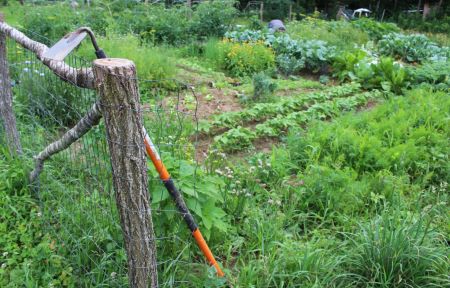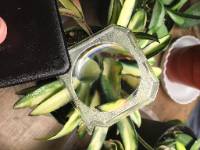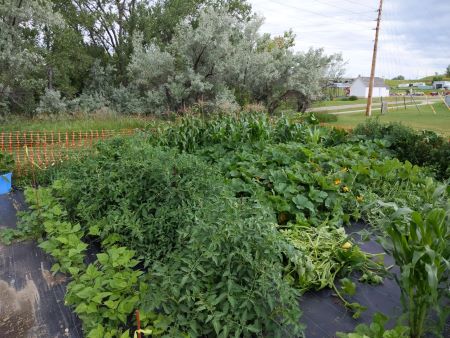Integrated Pest Management

It seems that this summer we have been dealing with a variety of insect pests of all shapes and sizes. No sooner did we get one issue sorted out than another one popped up causing major damage to the host plants. In several of those cases the best treatment was to use chemical to help control the pests however, chemicals may not always be the best first response to seeing an insect in your garden, landscape or lawn. In many instances, unless the issue is severe, there are other steps that should be taken first to control the issue or in some cases there are steps that could have been taken to prevent the issue in the first place. I will never say that using chemicals is bad as they are an important tool in the tool box but they should never be the only tool that we use. This week we are going to talk about Integrated Pest Management and its importance for the home gardener.
Integrated pest management or IPM is a comprehensive approach to managing pests in your home garden, landscape and lawn. IPM is characterized by using a variety of different methods to control pests while causing the least amount of harm to the environment, people and property. The goal is to manage the insects at levels that will not cause harm to the desirable plants but does not focus on eliminating the pests completely. While your first thought might be that getting rid of the problem insects would be the best option in many cases those insects support a population of beneficial insects that help our plants or the amount of chemical needed to completely eliminate the issue would cause major harm to the environment. IPM looks at managing pests through three different avenues: cultural, biological and finally chemical means.
Cultural Control- One of the first steps with IPM involves using cultural control methods to create an environment that is less attractive for insects. The goal is to reduce pest establishment, survival, reproduction and dispersal either by making small changes to how you garden. Cultural control can be things such as changing your irrigation practices to reduce disease issues to using mulches around plants to using traps to scout for insects before they become an issue.
Biological Control- An important aspect of IPM is to utilize natural beneficial insects as much as possible to help reduce the number of harmful insects in your garden. Biological control can refer to using natural predators to attack aphids or it could also include cultural methods such as using poly cultures to encourage more natural predators in the garden.
Chemical Control- Last but certainly not least is the use of chemicals to help control insect or disease issues in the garden. In IPM practices chemicals are used in combination with cultural and biological controls for a more effective long-term control. The chemicals used should be selected for their lack of impact on the environment and their efficiency at controlling the pest. You want to use as selective a chemical as possible. With IPM you should wait to apply chemicals till you reach the threshold for that particular plant and the insect pest in question. As I stated earlier, chemicals are an important tool in the tool box however the key is to make sure you are using the right tool for the right issue.
The first step in IPM is to think before you plant any plant. Plants that aren’t suited for that location will be more likely to be stressed and those plants will have more pest issues than plants that are in conditions they prefer. In a vegetable garden it is important to rotate your plants rather than planting the same thing in the same spot every year. There has also been some research that shows planting monocultures of vegetables could increase the pest issues versus utilizing a polyculture. If possible encourage beneficial insects such as parasitic wasps, lady bugs and lacewings that can help to control the pest’s outbreaks before they become a problem. The second step is to work to keep your plant as healthy as possible (I know that’s always the goal) so they are less likely to have pest issues. Avoid over watering or over fertilizing thinking this will help the plants, it actually makes them more likely to have issues with insects because of the extra growth. The third step is one that we already do routinely and that is to scout your plants on a regular basis. Don’t check the same plant in a row each time, try to check different plants or multiple plants in a section. If you do find a pest, identify it before beginning any treatment. One of the most important aspects of IPM is to always figure out what is causing the problem you are seeing.
that we already do routinely and that is to scout your plants on a regular basis. Don’t check the same plant in a row each time, try to check different plants or multiple plants in a section. If you do find a pest, identify it before beginning any treatment. One of the most important aspects of IPM is to always figure out what is causing the problem you are seeing.
When you do find an issue, because let’s be honest at some point you will, try to remove the affected leaves or the insect itself if possible. If the plant is heavily infested it might be best to remove the plant completely as it will be very difficult to bring those insects down to a manageable level. If you see pests show up, don’t treat immediately, check for beneficial insects to see if they are handling the issue and if the issue is only cosmetic damage there isn’t a need to treat. Every plant has what we call a “threshold level” for an insect which is the level of the pest population at which the plant is approaching yield loss. This is the level at which it is important to start treating. This could be expressed in the number of insects per leaf or the number of plants with pests in a row. If possible find out what that level is and wait to treat till you reach that level. When treating for any insect pest try to use a selective chemical rather than a broad-spectrum product. There has been some research that has shown that the use of broad-spectrum products can actually make an issue worse by killing any beneficial insects that were there helping to control the pest. If you just need to tap a nail into a picture frame a sledgehammer won’t be your best option, but a small hammer would be. Try to spray any product early in the morning or right at dusk to reduce the chances of hurting beneficial insects.
Integrated Pest Management involves many techniques that gardeners are already doing in their yards and gardens. For many all it takes is a few adjustments to your current routine to utilize IPM at your home. Remember if you are using any chemical, even organic ones, you need to read and follow the label at all times for the product to be the most effective. Many times, when people tell me a product failed to work properly it was because they hadn’t been applying as recommended on the label.


Have questions? Contact our office where our Horticulture Extension Agent will assist you with questions.
Phone: (316) 321-9660
Email: callae@ksu.edu